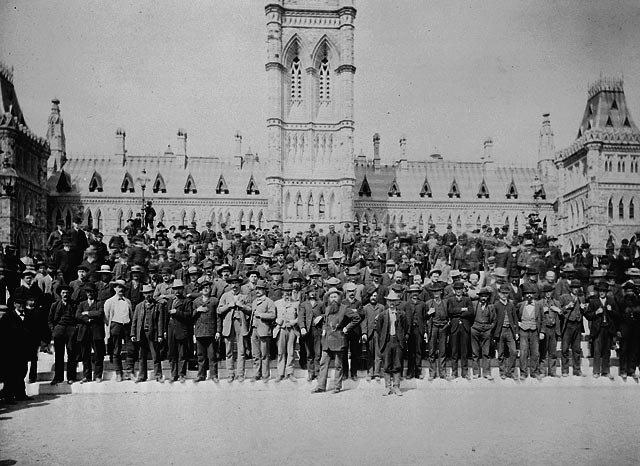
Background
In 1869, the Suez Canal was opened through Egypt. It shortened trade routes by connecting the Mediterranean and Red seas. By the late 1870s, Britain owned 44 per cent of the canal’s shares. To protect its interests in the region, Britain took control of Egypt and supported Egypt’s rule of its southern neighbour, Sudan.
British Lieutenant-General Sir Garnet Wolseley crushed an anti-British Egyptian nationalist uprising in 1882. In 1881, popular Muslim religious leader Mohammed Ahmed, the Mahdi (guide), had declared a jihad, or religious war, to rid Sudan of British-backed Egyptian rule. Many battles ensued until, in November 1883, British prime minister William Gladstone ordered the withdrawal of Egypt and Britain from Sudan.
In February 1884, the newly appointed Sudanese governor general, Major-General Charles Gordon, arrived at Sudan’s capital, Khartoum. He soon began the evacuations while also confronting Mahdists in military skirmishes and fortifying the city. On 13 March, Mahdists began a siege of Khartoum. The situation became increasingly desperate for Gordon. In early August, the British House of Commons authorized £300,000 towards operations to break the siege and rescue Gordon; Wolseley was put in charge of the expedition.

Preparations
Wolseley had been assigned to Canada in 1861. From May to August 1870, he recruited 400 voyageurs (including 100 Haudenosaunee) to transport British troops and Canadian militia through 1,000 km of rivers, lakes and portages in response to the Red River Resistance. (See Red River Expedition.) Wolseley’s Sudan mission would be similar in that he planned to move troops to Khartoum in a flotilla of boats up the Nile River.
In a message to the Canadian governor general, the Marquess of Lansdowne, Wolseley requested 300 Indigenous voyageurs from Caughnawaga (Kahnawake), Saint-Régis and Manitoba. Canadian prime minister Sir John A. Macdonald demanded that they serve as part of the British service and be paid by Britain.
There was an overwhelming response to newspaper advertisements that offered $30 to $40 per month plus expenses. In total, 379 boatmen were recruited for the expedition. Canadian Lieutenant-Colonel Frederick Denison, who had served in the Fenian Raids and Red River Resistance, was appointed to lead the contingent. He was joined by four other Canadian militia officers, a medical officer and hospital sergeant, and a priest.
The voyageurs who met in Montreal in September 1884 comprised English and French Canadians and more than 100 Métis, Mohawk and Haudenosaunee. Most were experienced boatsmen, but many were lumbermen and others seeking adventure.
The Mission
The voyageurs arrived in Alexandria on 7 October 1884 and took a train to Asyut, passing Cairo on the way. Waiting for them were the 9-m-long wooden whaling boats that they would use to transport about 5,000 troops and supplies. The boats had to travel 2,300 km south against the strong Nile current. The whalers were chained to steamboats and towed on the journey’s first leg. On 26 October, they arrived at the British garrison at Wadi Halfa. The steamboats could take them no farther.
Six-men crews rowed from sunrise to sunset. In shallow sections, they had to push the boats forward with long poles. Rapids forced men to either wade while pulling the heavy boats with ropes or undertake laborious portages. Accompanying the flotilla was a camel caravan of 1,800 British soldiers. It carried supplies, helped with portages, and offered protection from Mahdi.
In January, the voyageurs’ enlistments expired and most opted to return to Canada. They were welcomed in Ottawa with a celebratory meal and parade. Meanwhile, at Korti, Wolseley sent the caravan south. Those who had re-enlisted (about 85 in number) embarked on the Nile’s long loop east, south, and then back west to reunite with the caravan. Progress was slowed by unexpected rapids. On 17 January, the caravan was attacked at Abu Klea. The British troops defeated the attacking Mahdi but suffered 380 casualties.
On 26 January, a force of 50,000 Mahdi took Khartoum. Thousands of slain bodies lay on the streets and Gordon’s severed head was displayed on a pike. The flotilla arrived two days later.
On 10 February, the British troops fought a large force of Mahdi near Kirbekan. While the voyageurs stayed with the boats, Denison joined in the battle. The British were victorious, inflicting heavy casualties on the Mahdi force. Between 200 and 700 Mahdi died during the battle, compared to 12 British soldiers. The British force was then ordered to retreat to Egypt. As this meant running the river, the skills of the Canadian boatmen were crucial, particularly in sections with dangerous rapids. The flotilla reached Wolseley at Korti on 8 March and the Canadians left for Alexandria soon after. On 17 April, they sailed for England; their expedition was over.

Legacy
During the Nile Expedition (14 September 1884 to 17 April 1885), eight voyageurs succumbed to disease (including Denison, who died of smallpox in London), six drowned, and two died in a train accident. While ultimately a failure, it marked the first time that a Canadian contingent had served overseas.

 Share on Facebook
Share on Facebook Share on X
Share on X Share by Email
Share by Email Share on Google Classroom
Share on Google Classroom







